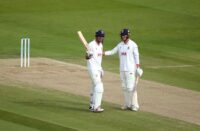Derek Pringle looks at the moves to sign Kolpak players in county cricket despite calls for the pathway to be blocked
The whispers surrounding Kyle Abbott’s intention to join Hampshire on a long contract and thereby relinquish an international career with South Africa seem to be yet another consequence of the transformation politics at play in that country. But as talented cricketers across the Rand Republic consider their futures, will it trigger a return to that recent trend in county cricket – the mass return of the Kolpak player?
Nobody in English cricket has ever quite worked out whether Kolpaks are ‘friend’ or ‘foe’. Only that, as the quota system is wielded more bluntly in countries like South Africa, they have become more plentiful – the combination of disillusionment on their part and the search for short-term fixes by counties providing optimum conditions for their propagation.
The mid-to-late 2000s were probably their heyday. Then, 60 Kolpaks were employed by the 18 first-class counties. Indeed, in May 2008, when Leicestershire played Northamptonshire in the County Championship, 13 Kolpaks were involved in the match, 10 of them from South Africa. It wasn’t for nothing that Northants became known as ‘Kolpakshire’ around that time.
For those not au fait with the term Kolpak, it stems from a Slovakia handball player, Maros Kolpak, who went to the European Court of Justice to win the right to play in the German handball leagues. Slovakia was not a member of the European union at the time, but they did have a trade agreement with the EU which made Kolpak’s participation legal. The Cotonou Treaty is a corollary of that trade agreement and involves hundreds of other mainly African, Caribbean and Pacific countries, of which South Africa is one.
Most Kolpak players in county cricket are misnamed as they are eligible under the Cotonou Treaty, but it is the Kolpak description which has stuck.
Despite the legality, there are those who will dismiss Kolpaks as a routinely bad thing for English cricket, their very presence denying British-born players, especially young ones, from crucial opportunities in the first team. Actually, the argument was never as simple as that and setting aside the self-interests which lead counties to sign Kolpaks in the first place (promotion to Division One, avoidance of relegation to Division Two, reaching T20 finals day etc), the fact that such players were fully developed actually raised standards in county cricket.
Economic consequences brings pragmatism though and given the choice between playing a decent Kolpak cricketer, who knew the ropes, or a home grown youngster with their potential not yet realised, many counties opted for the former. For most chairmen and chief executives and former businessmen, the promise of a quick return on their investment proved seductive, especially as they cost less than top-notch overseas players whose numbers were, in any case, restricted.
The England and Wales Cricket Board were not so enamoured that young England-qualified cricketers should be denied opportunities to improve, and introduced a mix of ‘stick and carrot’ measures to wean counties off signing Kolpaks. Beginning with fines for each Kolpak before turning to incentive payments for the amount of England qualified players each county fielded – the money involved either way was never significant enough to affect the wealthier counties like Surrey.
Kolpak numbers did eventually decline, though this was due more to changes in Employment Law which, in 2008, demanded Kolpaks secure a four-year working visa rather than the holiday work visa they needed, originally, to work in the UK.
Although never entirely extinguished, Kolpaks appear to be undergoing something of a renaissance in 2017. Although the status of some players remains unclear, there will be about 15 Kolpaks involved in county cricket next season. Down from their peak, but that may be because many have found savvier ways of becoming eligible, such as European passports or discovering long forgotten British grandparents. After Abbott joined Hampshire, he added to the number of several South Africans – disillusioned by selection quotas that require at least five persons of colour to be picked for the national side and six at state level – now seeking stability through county cricket. Others trying on their new Kolpak cloak for 2017 include Hardus Viljoen at Derbyshire, Simon Harmer at Essex, Stiaan van Zyl at Sussex and Rilee Rossouw at Hampshire.
My old county Essex have tried to avoid the Kolpak route previously, but have found it hard not to be tempted this time following promotion to Division One. They have also needed to come to terms with the loss of two frontline bowlers, David Masters and Graham Napier, through retirement, departures that have left a gaping 100-wicket hole in their attack.
With previous excursions to Division One ending in instant relegation, Essex are determined to avoid another yo-yo in 2017. As a result, they have signed Harmer, an off-spinning all-rounder from Port Elizabeth as a Kolpak, as well as two overseas pace bowlers, Neil Wagner and Mohammad Amir, to help them stay up. Their batting, especially after the return of Varun Chopra and Adam Wheater, is mostly home grown and even with their ‘foreign’ contingent they hope to field at least seven England-qualified players for Championship matches.
Hampshire’s philosophy is based on the same premise (avoiding relegation), but involves a slightly different approach. Having survived relegation only by dint of Durham being sent down due to financial mismanagement, they believe the only way to survive in the top division is to have a phalanx of decent pace bowlers and rotate them when injury and fatigue dictate. To that end, and assuming Abbott joins them, they will have two Kolpaks, the other being Fidel Edwards, the former West Indies Test player.
In addition to them are Gareth Berg (Italian passport so qualifies under EU, which gives him at least two years once the government triggers Article 50 in March), Brad Wheal (born in South Africa, but with Scottish parentage) and then the British-born quartet of Reece Topley, Chris Wood, Asher Hart and Ryan Stevenson.
Like Essex, Hampshire say they are mindful of England’s needs through the development of young home-grown players, but feel they need to be competitive at the same time. That is the balancing act between playing Kolpak, overseas and EU-qualified cricketers and locally-raised ones throughout county cricket today.
With early noises from the government suggesting that EU workers currently employed in the UK will be able to stay on post-Brexit, it could be that the current Kolpak surge is being driven by a “get in while you can” imperative. Yet, love or loathe the Kolpaks, they have been forced to show a great deal of ingenuity just to play county cricket – and that marks them out before anything else is taken into consideration of whether they have enhanced or deprived the English game.
This piece originally featured in The Cricket Paper, January 6 2017
Subscribe to the digital edition of The Cricket Paper here












